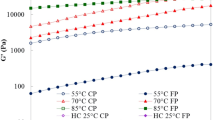Abstract
The recoverable energy (RE), defined as the ratio of the work exerted on a test specimen during compression and recovered upon subsequent decompression, has been shown to correlate to sensory profiling of protein-based food products. Understanding the mechanism determining the time-dependency of RE is primordial. This work aims to identify the protein-specific impact on the recoverable energy by stress dissipation via relaxation of (micro)structural rearrangements within protein gels. To this end, caseinate and gelatin gels are studied for their response to time-dependent mechanical deformation as they are known to develop structurally distinct network morphologies. This work shows that in gelatin gels no significant stress relaxation occurs on the seconds timescale, and consequently no time-dependency of the amount of energy stored in this material is observed. In caseinate gels, however, the energy dissipation via relaxation processes does contribute significantly to the time-dependency of reversible stored energy in the network. This can explain the obtained RE as a function of applied deformation at slow deformation rates. At faster deformation, an additional contribution to the dissipated energy is apparent, that increases with the deformation rate, which might point to the role of energy dissipation related to friction of the serum entrapped by the protein-network. This work shows that engineering strategies focused on controlling viscous flow in protein gels could be more effective to dictate the ability to elastically store energy in protein gels than routes that direct protein-specific aggregation and/or network-assembly.









Similar content being viewed by others
References
Baumberger, T., Caroli, C., Martina, D.: Solvent control of crack dynamics in a reversible hydrogel. Nat. Mater. 5, 552–555 (2006)
Chu, B., Zhou, Z., Wu, G., Farrell, H.M.: Laser light scattering of model casein solutions: effects of high temperature. J. Colloid Interface Sci. 170, 102–112 (1995)
Dalgleish, D.G., Spagnuolo, P.A., Goff, H.D.: A possible structure of the casein micelle based on high-resolution field-emission scanning electron microscopy. Int. Dairy J. 14, 1025–1031 (2004)
de Jong, S., de Jongh, H.H.J.: On the observation and correction of resilience stress during mechanical deformation of semi-solid specimens. Supplementary material (2015)
de Jongh, H.H.J.: The included water phase as determinant for perception of gelled food structures. Food Biophys. 6, 303–312 (2011)
de Wijk, R.A., Janssen, A.M., Prinz, J.M.: Oral movements and the perception of semi-solid foods. Physiol. Behav. 104, 423–428 (2011)
Di Monaco, R., Cavella, S., Masi, P.: Predicting sensory cohesiveness, hardness and springiness of solid foods from instrumental measurements. J. Texture Stud. 39, 129–149 (2008)
Hang, F., Gupta, H.S., Barber, A.H.: Nanointerfacial strength between non-collagenous protein and collagen fibrils in antler bone. J. R. Soc. Interface 11, 20130993 (2014). doi:10.1098/rsif.2013.0993
Lowe, L.L., Foegeding, E.A., Daubert, C.R.: Rheological properties of fine-stranded whey protein isolate gels. Food Hydrocoll. 17, 515–522 (2003)
Mao, R., Tang, J., Swanson, B.G.: Relaxation time spectrum of hydrogels by CONTIN analysis. J. Food Sci. 65, 374–381 (2000)
Matsukawa, S., Ding, Y., Zhao, Q., Mogi, A., Tashiro, Y., Ogawa, H.: Effect of solvent transfer in agar gels on stress relaxation under large deformation. Carbohydr. Polym. 109, 166–170 (2014)
Okuyama, K., Xu, X., Iguchi, M., Noguchi, K.: Revision of collagen molecular structure. Biopolymers 84, 181–191 (2006)
Peleg, M.: Texture profile analysis parameters obtained by an Instron universal testing machine. J. Food Sci. 41, 721–722 (1976)
Peleg, M.: Characterization of the stress relaxation curves of solid foods. J. Food Sci. 44, 277–281 (1979)
Pouzot, M., Nicolai, T., Benyahia, L., Durand, D.: Strain hardening and fracture of heat-set fractal globular protein gels. J. Colloid Interface Sci. 15, 376–383 (2006)
Rabiey, L., Britten, M.: Effect of protein composition on the rheological properties of acid-induced whey protein gels. Food Hydrocoll. 23, 973–979 (2009)
Ross-Murphy, S.B.: Structure and rheology of gelatin gels: recent progress. Polymer 33, 2622–2627 (1992)
Tobolsky, A., Eyring, H.: Mechanical properties of polymeric materials. J. Chem. Phys. 11, 125–134 (1943)
Urbonaite, V., de Jongh, H.H.J., van der Linden, E., Pouvreau, L.: Origin of water loss of soy protein gels. J. Agric. Food Chem. 62, 7550–7558 (2014)
van den Berg, L., van Vliet, T., van der Linden, E., van Boekel, M.A.J.S., van de Velde, F.: Serum release: the hidden quality in fracturing composites. Food Hydrocoll. 21, 420–432 (2007a)
van den Berg, L., van Vliet, T., van der Linden, E., van Boekel, M.A.J.S., van de Velde, F.: Breakdown properties and sensory perception of whey proteins/polysaccharide mixed gels as a function of microstructure. Food Hydrocoll. 21, 961–976 (2007b)
van den Berg, L., Carolas, A.L., van Vliet, T., van der Linden, E., van Boekel, M.A.J.S., van de Velde, F.: Energy storage controls crumbly perception in whey proteins/polysaccharide mixed gels. Food Hydrocoll. 22, 1404–1417 (2008)
van Vliet, T.: Rheology and Fracture Mechanics of Foods. CRC Press, Boca Raton (2013). Chapter 5
van Vliet, T., Walstra, P.: Large deformation and fracture behaviour of gels. Faraday Discuss. 101, 359–370 (1995)
van Vliet, T., Van Dijk, H.J.M., Zoon, P., Walstra, P.: Relation between syneresis and rheological properties of particle gels. Colloid Polym. Sci. 269, 620–627 (1991)
Author information
Authors and Affiliations
Corresponding author
Rights and permissions
About this article
Cite this article
de Jong, S., van Vliet, T. & de Jongh, H.H.J. The contribution of time-dependent stress relaxation in protein gels to the recoverable energy that is used as a tool to describe food texture. Mech Time-Depend Mater 19, 505–518 (2015). https://doi.org/10.1007/s11043-015-9275-7
Received:
Accepted:
Published:
Issue Date:
DOI: https://doi.org/10.1007/s11043-015-9275-7




